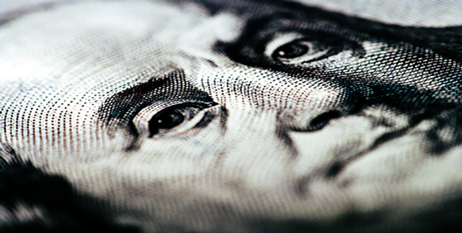Gold prices rose to 17-month highs last week, boosted by a report of slow economic growth and a flagging U.S. dollar.
In fact, the dollar just suffered one of its biggest weekly declines since May and is down over 3% in January alone.
The stock market has been catching some of that negative wind. Today the Dow Jones fell almost 300 points before 9am PST, and Goldman Sachs said all indicators pointed to a 10-20% drop on the immediate horizon.
According to Bloomberg analysis, 2017 was a bad one for our currency. They just described it as “the most depreciated dollar we’ve seen in 15 years.”
The U.S. Dollar Index was down almost 10%… and it hasn’t declined that much since 2003! Only 2 years out of the last 18 have been as bad as last year for the dollar.
COULD 2018 BE EVEN WORSE?
So far, the dollar is down against every single other G10 currency. According to Bloomberg, this is the worst yearly start for the dollar since 1987. This kind of falling dollar velocity has only been seen in a handful of the last 50 years, indicating something is different.
It doesn’t take a long memory to know that it hasn’t always been this way.
The U.S. has traditionally been a staunch believer in a strong currency, making it the most desirable money in the world. Robert Rubin, former Treasury Secretary, famously said in 1995 that a strong dollar is in the national interest. U.S. consumers have gotten used to increased buying power when shopping for imported goods.
While no one wants to see the dollar fall, many investors are taking action and considering how to protect their assets in the face of its inevitable further slide.
“This is gold’s breakout year,” says noted metals analyst Jim Rickards. “We are in the third bull market [for metals] in my lifetime – and we have a very long way to run.”
WHAT’S GOING ON WITH OUR DOLLAR?
It is clear: the greenback is facing an uphill battle. Here are some big reasons:
Political Messages
Since his election, President Trump has been consistent in talking down the dollar in his public remarks, saying that a lower dollar would be good for trade. The dollar began an eight-month slide shortly after the President and U.S. Treasury Secretary Steven Mnuchin spoke favorably about a lower dollar in January 2017.
A short recovery in the fall was obliterated when Mnuchin spoke out again in January 2018, saying “a weaker dollar is good for us.”
So far, the dollar is down 11% since President Trump took office.
A Slowing Economy
U.S. stocks have been booming over the last year, but the underpinning is not as rosy as it might appear.
The U.S. was actually last in investment performance and employment growth among all the major world economies in 2017.
This was the first time this happened in a decade!
Protectionist trade policies by the new administration have been part of this decline. Last year was the first since 2008 that Europe created more jobs than the U.S., and productivity rose overseas while falling in the U.S.A.
Our country’s lingering flirtation with government shutdown hurts the general business climate as well as government tax receipts.
Multi-Year Deficits Begin in 2018
A report by the Committee for a Responsible Federal Budget, a Washington think tank, just found that 2019 is likely to see a budget deficit in excess of $1 trillion. Their estimates show that this shortfall would continue, and increase, to a record $2 trillion deficit by 2027!
This continuing fiscal irresponsibility is a big reason why foreign interests are now less interested these days in holding our currency long term.
Competition From Other Reserve Currencies
The dollar has been used for as much as 45% of international transactions in recent years, but in recent months that percentage has fallen below 40%. Investors also bid up European securities over U.S. securities last year.
“We really struggle to see who is going to be buying U.S. assets,” said George Saravelos at Deutsche Bank, who expects a Euro rally at the expense of the dollar.
A WEAK DOLLAR IS THE NEW U.S. AGENDA
U.S. Global Investors head trader Michael Matousek says a weaker dollar could drive gold higher and he thinks the precious metal is on an uptrend.
Thomson Reuters GFMS analysts predict volatility in equities and more global political uncertainty, which could lead gold prices up past $1,500 an ounce this year.
President Trump and his administration are clearly signifying that he’s willing to join ranks with other countries that have weakened their currencies to get a leg-up in world trade.
A less muscular greenback aligns with Trump’s protectionist policies: a desire for lower trade deficits, increased export of American goods, renegotiated trade deals and higher tariffs.
However, Leuthold Group strategist Jim Paulsen warns of danger right ahead. According to Paulsen, a weak dollar in a fully employed economy with rising inflation combined with historically low bond yields and high P/E ratios is a terrible cocktail for the financial markets.
But it isn’t too late for you to take action and get protected now. There might never be a better time to consider acquiring gold or opening a Gold IRA.
ARE YOU BUILDING ON A FOUNDATION OF SAND?
EverBank president of World Markets Chris Gaffney says if we get a major black swan event or a major correction in the equity markets, we could easily see gold investors flood into the market.
Regardless, the World Gold Council has identified favorable trends that should support gold prices in the coming years. With the U.S. dollar under pressure and signs of inflation emerging, owning physical gold or silver could be something to consider now.






